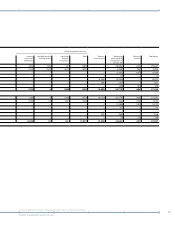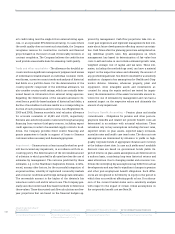Siemens 2009 Annual Report Download - page 222
Download and view the complete annual report
Please find page 222 of the 2009 Siemens annual report below. You can navigate through the pages in the report by either clicking on the pages listed below, or by using the keyword search tool below to find specific information within the annual report.
Reports Supervisory Board /
Managing Board Corporate Governance Management’s discussion and analysis Consolidated Financial Statements
Consolidated Statements of Income Consolidated Statements of Income
and Expense Recognized in Equity
Consolidated Balance Sheets Consolidated Statements of Cash Flow
tion. If the effect is material, provisions are recognized at pres-
ent value by discounting the expected future cash flows at a
pre-tax rate that reflects current market assessments of the
time value of money. Provisions for onerous contracts are mea-
sured at the lower of the expected cost of fulfilling the contract
and the expected cost of terminating the contract. Additions to
provisions are generally recognized in the income statement.
The present value of legal obligations associated with the re-
tirement of property, plant and equipment (asset retirement
obligations) that result from the acquisition, construction, de-
velopment or normal use of an asset is added to the carrying
amount of the related asset. The additional carrying amount is
depreciated over the useful life of the related asset. If the asset
retirement obligation is settled for other than the carrying
amount of the liability, the Company recognizes a gain or loss
on settlement.
Termination benefits – are recognized in the period incurred
and when the amount is reasonably estimable. Termination
benefits in accordance with IAS 19 are recognized as a liability
and an expense when the entity is demonstrably committed,
through a formal termination plan, to either provide termina-
tion benefits as a result of an offer made in order to encourage
voluntary redundancy or terminate employment before the
normal retirement date.
Financial instruments – A financial instrument is any contract
that gives rise to a financial asset of one entity and a financial
liability or equity instrument of another entity. Financial as-
sets of the Company mainly include cash and cash equivalents,
available-for-sale financial assets, trade receivables, loans re-
ceivable, finance lease receivables and derivative financial in-
struments with a positive fair value. Cash and cash equivalents
are not included within the category available-for-sale finan-
cial assets as these financial instruments are not subject to
value fluctuation within the Company. Siemens does not make
use of the category held to maturity. Financial liabilities of the
Company mainly comprise notes and bonds, loans from banks,
commercial paper, trade payables, finance lease payables and
derivative financial instruments with a negative fair value.
Siemens does not make use of the option to designate finan-
cial assets or financial liabilities at fair value through profit or
loss at inception (Fair Value Option). Based on their nature, fi-
able income will be available against which the deductible
temporary differences, unused tax losses and unused tax cred-
its can be utilized.
Inventories – Inventory is valued at the lower of acquisition or
production cost and net realizable value, cost being generally
determined on the basis of an average or first-in, first-out
method. Production costs comprise direct material and labor
and applicable manufacturing overheads, including deprecia-
tion charges. Net realizable value is the estimated selling price
in the ordinary course of business, less the estimated costs of
completion and selling expenses.
Defined benefit plans – Siemens measures the entitlements
of the defined benefit plans by an actuarially calculated net
present value of the future benefit entitlement for services al-
ready rendered. In determining the net present value of the
future benefit entitlement for service already rendered (De-
fined Benefit Obligation (DBO)). Siemens considers future
compensation and benefit increases, because the employee’s
final benefit entitlement at regular retirement age depends on
future compensation or benefit increases.
For unfunded plans, Siemens recognizes a pension liability
equal to the DBO adjusted by unrecognized past service cost.
For funded plans, Siemens offsets the fair value of the plan as-
sets with the benefit obligations. Siemens recognizes the net
amount, after adjustments for effects relating to unrecognized
past service cost and any asset ceiling, under pension liability
or pension asset.
Actuarial gains and losses, resulting for example from an ad-
justment of the discount rate or from a difference between ac-
tual and expected return on plan assets, are recognized by
Siemens in the Consolidated Statements of Income and Ex-
pense recognized in Equity in the year in which they occur.
Those effects are recorded in full directly in equity, net of tax.
Provisions – A provision is recognized in the balance sheet
when the Company has a present legal or constructive obliga-
tion as a result of a past event, it is probable that an outflow of
economic benefits will be required to settle the obligation and
a reliable estimate can be made of the amount of the obliga-
























